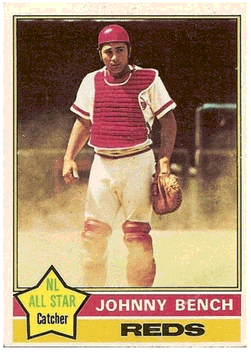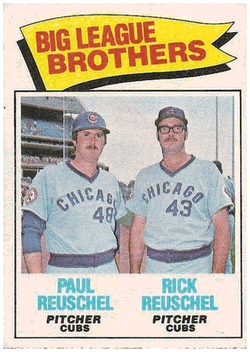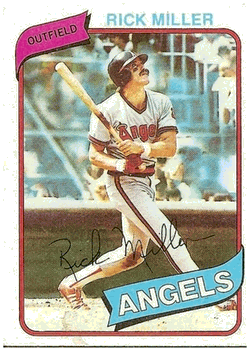Cardboard Gods (9 page)
Authors: Josh Wilker

Topps 1976 #300: Johnny Bench




With my baseball cards, as with little else, I knew where I stood. I owed this feeling of solidity in part to Topps's practice of numbering their cards in such a way as to signal a four-level hierarchy of gods. If the number of a card ended in anything but a 0 or a 5, the player on that card resided on the bottom level of the hierarchy, a level so broad it included almost everyoneâall the steady, colorless regulars and flawed reserves, all the hasbeens and never-weres, all the green big-eyed hopefuls and graying squint-eyed hangers-on. Owchinko, Terpko, Heaverlo, Rapp, Nicosia, Barlow, Nahorodny, Knapp. One level up included players whose card numbers ended in 5; these players had made an All-Star Game or two, perhaps, or were just a couple decent if unspectacular years removed from a Rookie of the Year award, or had recently vied for, but not won, a batting crown. McRae, Wise, Hendrick, Tanana. Rising still higher, players whose card numbers ended in 0 had been to a few All-Star Games and seemed likely to be going to a few more before they were done. Madlock, Blue, Cey. And at the very top of this steep mountain were the players whose card numbers ended in 00. These were the superstars, among the best to ever play the game. There were only a handful of these players in every set.
The photo on this card, number 300 in the 1976 series, is most likely from the 1975 season, in which Johnny Bench's team, the Cincinnati Reds, won 108 regular-season games and then bested the Red Sox in a legendary World Series. Though I have since steeped myself down to the last detail of the 1975 World Series (that last detail being Yaz coming to bat with two outs in the bottom of the
ninth of Game Seven with the Red Sox down a run and 30,000 voices screaming,
Come on, Yaz!
until the man they were screaming for popped out to César Gerónimo in center field), I missed the whole thing as it happened, all the action broadcast on NBC, which we couldn't get in East Randolph. In later years, I'd listen to games on the radio that I couldn't see on TV, but in 1975 I may not have even known that radio was an option, and if I did I may have not yet been able to follow a game that way. So I had to rely on my imagination and my cards to piece together what had happened to the Red Sox when they faced Johnny Bench and the Reds.
ninth of Game Seven with the Red Sox down a run and 30,000 voices screaming,
Come on, Yaz!
until the man they were screaming for popped out to César Gerónimo in center field), I missed the whole thing as it happened, all the action broadcast on NBC, which we couldn't get in East Randolph. In later years, I'd listen to games on the radio that I couldn't see on TV, but in 1975 I may not have even known that radio was an option, and if I did I may have not yet been able to follow a game that way. So I had to rely on my imagination and my cards to piece together what had happened to the Red Sox when they faced Johnny Bench and the Reds.
This particular card told me just about all I needed to know. With dust rising all around him, Johnny Bench is the gunslinger who has just downed one challenger and who is now eyeing the next as if to say, “You really think that's a good idea? Really?”
At times I imagined that he'd just gunned down a runner, and at other times I imagined that he'd just gunned down the whole league, including the Red Sox. At the end of the year, after the Reds again won more than 100 games during the regular season, Bench single-handedly demolished the Yankees in the Reds' four-game sweep of the 1976 World Series. That was also on NBC, so I didn't learn about it until my brother's
Sports Illustrated
showed up in the mail with Johnny Bench on the cover, launching a home run. The caption asked a questionâ“How good are the Reds?”âthat even at age eight I understood was not really a question but a throwing up of the hands: Johnny Bench's Reds are so good, you can't even explain how good they are.
Sports Illustrated
showed up in the mail with Johnny Bench on the cover, launching a home run. The caption asked a questionâ“How good are the Reds?”âthat even at age eight I understood was not really a question but a throwing up of the hands: Johnny Bench's Reds are so good, you can't even explain how good they are.
Bench's 1976 card stood out even more than the other superstar cards from that year. His gunslinger pose revealed him as a hero from an earlier, simpler time, the last of a dying breed. By then the classic Western, along with the clearly defined model of tough, decisive American maleness that fueled the genre, seemed to be limping its final gut-shot paces. John Wayne was old, and in his wake had come a new version of what it meant to be an American man. A boy growing up in the 1950s could follow the path to maleness pretty easily: Be tough, play to win, salute the flag, shoot a few savages if necessary, and let the womenfolk cook and clean and weep and such. But a boy growing up in the 1970s had to cling to the last few shreds of that simple path wherever he found them while besieged on all sides by uncertainty.
The two most popular television shows of the era,
All in the Family
and
M*A*S*H
, prominently featured characters (Archie Bunker and Frank Burns, respectively) whose histrionic embracing of the John Wayne Way was continuously lampooned as rigid, anachronistic, and just plain wrong. Meanwhile, in schoolyards all over the country, especially schoolyards that served hippie-influenced classrooms such as mine, children were encouraged to play something called “New Games,” which were all, if the photos in the New Games book were any guide, invented by ambiguously gendered giggling longhairs prancing across meadows under the influence of potent hallucinogens. All the New Games valued toothless hand-holding cooperation over competition and had no real rules, only suggestive guidelines and the foundational dictate that there were never to be winners or losers. My free-school class owned the book and also a rainbow-colored parachute that served as the centerpiece for the New Games' most elaborate invention, which proved to have all the drama and enjoyment of folding and unfolding a gigantic multicolored bed sheet. I never took to New Games, but I can't say I didn't love another more powerful contributor to the decade's gamboling corrosion of What Was What and Who Was Who:
Free to Be You and Me
.
All in the Family
and
M*A*S*H
, prominently featured characters (Archie Bunker and Frank Burns, respectively) whose histrionic embracing of the John Wayne Way was continuously lampooned as rigid, anachronistic, and just plain wrong. Meanwhile, in schoolyards all over the country, especially schoolyards that served hippie-influenced classrooms such as mine, children were encouraged to play something called “New Games,” which were all, if the photos in the New Games book were any guide, invented by ambiguously gendered giggling longhairs prancing across meadows under the influence of potent hallucinogens. All the New Games valued toothless hand-holding cooperation over competition and had no real rules, only suggestive guidelines and the foundational dictate that there were never to be winners or losers. My free-school class owned the book and also a rainbow-colored parachute that served as the centerpiece for the New Games' most elaborate invention, which proved to have all the drama and enjoyment of folding and unfolding a gigantic multicolored bed sheet. I never took to New Games, but I can't say I didn't love another more powerful contributor to the decade's gamboling corrosion of What Was What and Who Was Who:
Free to Be You and Me
.
The massively popular child-targeting musical television special and accompanying massively popular album got children all over America singing along to catchy, ebullient ditties about girls doing boy things and boys doing girl things. How silly to walk in a well-worn rut! How silly to pretend to be tough or care about being first! How wonderful to be whatever you want to be! Traditional sports made a couple notable appearances, but only as a kind of foil. In one song, a gigantic real-life NFL player who had once been a member of the Los Angeles Rams' legendarily menacing “Fearsome Foursome” defensive line now comforted a boy named Dudley Pippin who had worried that he was “a sissy” because he broke into sobs. “It's all right to cry,” crooned the former athlete who had once crushed guys to the turf with bone-shattering tackles. (Adding to the confusion, the hulking singer had the first name of a girl: Rosey.) In another song, “William's Doll,” a boy admits to his grandmother that he considers baseball his favorite sport but says, in a line that still makes me shudder, “I'd give my bat and ball and glove / to have a doll that I could love.”
Though I liked the album as much as anyone, “William's Doll” cut a little close to home, touching the same nerve that sparked my
anger whenever a stranger saw my long, curly hair and thought I was a girl. This happened a few times, especially in the years before I was old enough to play little league baseball and therefore able to wear my team cap everywhere, like an ID badge proving that I was, just like my brother and all my gods, not a little girl but a boy.
Topps 1977 #634: Big League Brothersanger whenever a stranger saw my long, curly hair and thought I was a girl. This happened a few times, especially in the years before I was old enough to play little league baseball and therefore able to wear my team cap everywhere, like an ID badge proving that I was, just like my brother and all my gods, not a little girl but a boy.

From the back of this card:
“Paul and Rick both picked up baseballs as soon as they were old enough.”
“Paul and Rick both picked up baseballs as soon as they were old enough.”
Â
Ian had started playing little league the year we moved to Vermont, away from our father. He wasn't very good at the beginning. After his little league games in his first year I always asked him the same question:
“Did you get a hit yet?”
The answer, no, was eventually rendered in the form of an I-Am-Going-to-Punch-You glare. By the end of the season I'd stopped asking. That summer we played catch in the yard of the house in Randolph Center, then, when we moved to East Randolph, we played catch and hit each other grounders and fly balls in the big yard alongside the house. I can't remember him ever giving me any specific instruction, but just by playing with me hour after hour, day after day, week after week, year after year, the ball sailing back and forth between us, a shared pulse, my brother taught me baseball.
Â
“They were teammates in little league, Pony League, High School and American Legion ball.”
Â
By the time I joined Ian on his little league team, the Mets, in 1977, he was one of the bigger and better kids in the league. Because I'd had him to practice with for two years, I was much more prepared to play than he'd been and got a hit in my first gameâa single off the end of the bat, up the first base line. The following year, his last in little league, Ian was a superstar, one of the three or four best players in the league along with the hulking Stu Townsend, the mustachioed
Tony Russo, and the seeming can't-miss future major leaguer Bob Chase. I'd always idolized my brother, but that year he was one of the select few in the league to hit the ball over the fence. I actually got to pour out of the dugout with all my teammates and meet him at home plate cheering.
Tony Russo, and the seeming can't-miss future major leaguer Bob Chase. I'd always idolized my brother, but that year he was one of the select few in the league to hit the ball over the fence. I actually got to pour out of the dugout with all my teammates and meet him at home plate cheering.
Â
“In one Pony League game, Paul hit a Homer to win it for himself.”
Â
Once I got a uniform that proved I was on my brother's team, I never wanted to be without a key piece of that uniform, the grass-green cap with the white felt
M
that turned darker and darker throughout the year as I wore it everywhere, all the time. Though I also owned Red Sox caps throughout my childhood, I remember wearing my little league cap more than once on the yearly trip to Fenway. I think I was wearing that cap and screaming myself hoarse when a man in front of us turned to my mother and said I must be a kid who “ate, slept, and breathed baseball.” I felt proud, and also happy to be defined. The man got it right: I was a kid who ate, slept, and breathed baseball. I was a kid who always wore the cap of the team he was on with his brother.
M
that turned darker and darker throughout the year as I wore it everywhere, all the time. Though I also owned Red Sox caps throughout my childhood, I remember wearing my little league cap more than once on the yearly trip to Fenway. I think I was wearing that cap and screaming myself hoarse when a man in front of us turned to my mother and said I must be a kid who “ate, slept, and breathed baseball.” I felt proud, and also happy to be defined. The man got it right: I was a kid who ate, slept, and breathed baseball. I was a kid who always wore the cap of the team he was on with his brother.
Without the cap, without baseball, without my brother, who was I? This question, though I never formulated it so specifically, has a lot to do with why I was drawn to this Big League Brothers card, and to all my cards in general. This card, as with other “special” cards, heightened the idea that the cards in total comprised a storybook world by using text on the back instead of centering primarily on numbers.
This text on the back of Paul and Rick Reuschel's Big League Brothers card was not the first thing that I noticed about this card, but I'm sure it gratified me when I finally got around to reading it, which would have been some time after my stomach stopped hurting from laughing by myself and then with my brother at the two stunned, doughy, beady-eyed lummoxes glowering apprehensively back at us. The story on the back of the card was of two brothers who loved baseball and who always stuck together. On other cards in the Big League Brothers series of 1977, the same basic story was told again and againâtwo brothers who loved baseball and stuck together, two brothers from a normal family that featured just two parentsâa mother and father with the same last name as the two
brothers, the father always around, tirelessly teaching both boys “the fundamentals.”
brothers, the father always around, tirelessly teaching both boys “the fundamentals.”
I knew my life didn't match the storybook one, but as long as I had my cap on my head and baseball cards in my hand I was able to imagine myself into that world. I could see a future that always included baseball and always included my brother, the two of us side by side on the same team in the Big Leagues.
Topps 1980 #48: Rick Miller
Other books
A Sense of Entitlement by Anna Loan-Wilsey
Warprize (Seven Brides for Seven Bastards, 5)(MFMMMMMM) by Georgia Fox
Star Wars - A Servant of the Empire - Unpublished by James L. Cambias
April Slaughter by Ghosthunting Texas
Worst Week Ever (A Long Road to Love) by O'Connor, Liza
Gentlemen Prefer Curves: A Perfect Fit Novel by Sugar Jamison
Falling Hard (Hidden Secrets Book 6) by Belden, P. J.
After The Virus by Meghan Ciana Doidge
Master of the Opera, Act 4: Dark Interlude by Jeffe Kennedy
